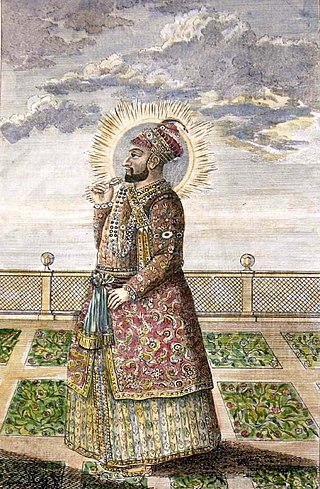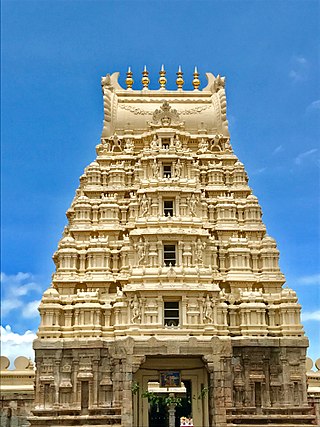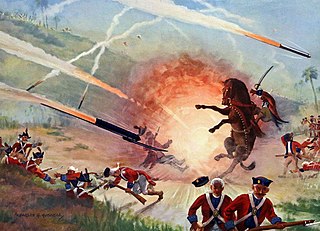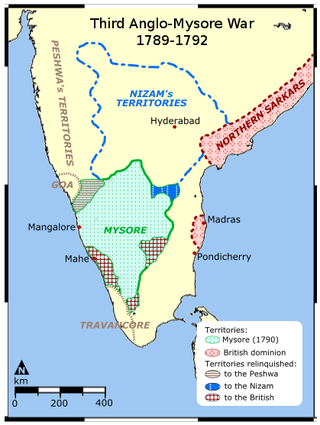
Tipu Sultan, commonly referred to as Sher-e-Mysore or "Tiger of Mysore", was the Indian Muslim ruler of the Kingdom of Mysore based in South India. He was a pioneer of rocket artillery. He introduced a number of administrative innovations during his rule, including a new coinage system and calendar, and a new land revenue system, which initiated the growth of the Mysore silk industry. Tipu was also a pioneer in introducing Channapatna toys. He expanded the iron-cased Mysorean rockets and commissioned the military manual Fathul Mujahidin. He deployed the rockets against advances of British forces and their allies during the Anglo-Mysore Wars, including the Battle of Pollilur and Siege of Srirangapatna.

The Congreve rocket was a type of rocket artillery designed by British inventor Sir William Congreve in 1808. The design was based upon the rockets deployed by the Kingdom of Mysore against the East India Company during the Second, Third, and Fourth Anglo-Mysore Wars. Lieutenant general Thomas Desaguliers, colonel commandant of the Royal Artillery at Woolwich, was impressed by reports of their effectiveness, and undertook several unsuccessful experiments to produce his own rocket weapons. Several captured Mysorean rockets were sent to Great Britain following the annexation of the Mysorean kingdom into British India following the death of Tipu Sultan in the siege of Seringapatam.

Hyder Ali was the Sultan and de facto ruler of the Kingdom of Mysore in southern India. Born as Hyder Ali, he distinguished himself as a soldier, eventually drawing the attention of Mysore's rulers. Rising to the post of Dalavayi (commander-in-chief) to Krishnaraja Wodeyar II, he came to dominate the titular monarch and the Mysore government. He became the de facto ruler of Mysore as Sarvadhikari by 1761. During intermittent conflicts against the East India Company during the First and Second Anglo–Mysore Wars, Hyder Ali was the military leader.

Srirangapatna is a town and headquarters of one of the seven Taluks of Mandya district, in the Indian State of Karnataka. It gets its name from the Ranganthaswamy temple consecrated around AD 984. Later, under the British rule, the city was renamed to Seringapatnam. Located near the city of Mandya, it is of religious, cultural and historic importance.

Sir William Congreve, 2nd Baronet KCH FRS was a British Army officer, Tory politician, publisher and inventor. A pioneer in the field of rocket artillery, he was renowned for his development and use of Congreve rockets during the Napoleonic Wars.

The Battle of Pollilur, also known as the Battle of Polilore or Battle of Perambakam, took place on 10 September 1780 at Pollilur near Conjeevaram, the city of Kanchipuram in present-day Tamil Nadu state, India, as part of the Second Anglo-Mysore War. It was fought between an army commanded by Tipu Sultan of the Kingdom of Mysore, and a British East India Company force led by William Baillie. The EIC force suffered a high number of casualties before surrendering. It was the worst loss the East India Company suffered on the subcontinent until Chillianwala. Benoît de Boigne, a French officer in the service of 6th Regiment of Madras Native Infantry, wrote, "There is not in India an example of a similar defeat".

The Kingdom of Mysore was a realm in the southern part of Deccan Plateau traditionally believed to have been founded in 1399 by two Hindu brothers, in the vicinity of the modern city of Mysore. From 1799 until 1950, it was a princely state, until 1947 in a subsidiary alliance with British India. The British took direct control over the princely state in 1831. Upon accession to the Dominion of India, it became Mysore State, later uniting with other Kannada speaking regions to form the state of Karnataka, with its ruler remaining as Rajapramukh until 1956, when he became the first governor of the reformed state.

The Second Anglo-Mysore War was a conflict between the Kingdom of Mysore and the British East India Company from 1780 to 1784. At the time, Mysore was a key French ally in India, and the conflict between Britain against the French and Dutch in the American Revolutionary War influenced Anglo-Mysorean hostilities in India. The great majority of soldiers on the company side were raised, trained, paid and commanded by the company, not the British government. However, the company's operations were also bolstered by Crown troops sent from Great Britain, and by troops from Hanover, which was also ruled by Great Britain's King George III.

The Anglo-Mysore Wars were a series of four wars fought during the last three decades of the 18th century between the Sultanate of Mysore on the one hand, and the British East India Company, Maratha Empire, Kingdom of Travancore, and the Kingdom of Hyderabad on the other. Hyder Ali and his succeeding son Tipu fought the wars on four fronts: with the British attacking from the west, south and east and the Nizam's forces attacking from the north. The fourth war resulted in the overthrow of the house of Hyder Ali and Tipu, and the dismantlement of Mysore to the benefit of the East India Company, which took control of much of the Indian subcontinent.

The Third Anglo-Mysore War (1790–1792) was a conflict in South India between the Kingdom of Mysore and the British East India Company, the Kingdom of Travancore, the Maratha Confederacy, and the Nizam of Hyderabad. It was the third of four Anglo-Mysore Wars.

The Fourth Anglo-Mysore War was a conflict in South India between the Kingdom of Mysore against the British East India Company and the Hyderabad Deccan in 1798–99.

The siege of Seringapatam was the final confrontation of the Fourth Anglo-Mysore War between the British East India Company and the Kingdom of Mysore. The British, with the allied Nizam Ali Khan, 2nd Nizam of Hyderabad and Marathas, achieved a decisive victory after breaching the walls of the fortress at Seringapatam and storming the citadel. The leader of the British troops was Major General David Baird, among the lesser known allies were the Portuguese in Goa and Damaon. Tipu Sultan, the de facto ruler after the death of his father, who had usurped the throne of Mysore, was killed in the action. The British restored the Wodeyar dynasty back to power after the victory through a treaty of subsidiary alliance and Krishnaraja Wodeyar III was crowned the King of Mysore. However, they retained indirect control of the kingdom's external affairs.

Rocket artillery is artillery that uses rockets as the projectile. The use of rocket artillery dates back to medieval China where devices such as fire arrows were used. Fire arrows were also used in multiple launch systems and transported via carts. The first true rocket artillery was developed in South Asia by the Tipu Sultan the ruler of the Kingdom of Mysore. In the late nineteenth century, due to improvements in the power and range of conventional artillery, the use of early military rockets declined; they were finally used on a small scale by both sides during the American Civil War. Modern rocket artillery was first employed during World War II, in the form of the German Nebelwerfer family of rocket ordnance designs, Soviet Katyusha-series and numerous other systems employed on a smaller scale by the Western allies and Japan. In modern use, the rockets are often guided by an internal guiding system or GPS in order to maintain accuracy.

Fathul Mujahidin is a military manual that was written in 1783 by Zainul Abedin Shustari at the instruction of Tipu Sultan, the ruler of the Kingdom of Mysore in South India considered a pioneer in the use of rocket artillery. Mysore started to equip their army with rockets in the 1750s and during the Second Anglo–Mysore War (1780–1784) Tipu and his father Haider Ali used this technology against British troops. Tipu Sultan used rockets in battle with the British Army in the 1792 Siege of Srirangapatna, a battle at the end of the Third Anglo-Mysore War.

The Battle of Mallavelly was fought on 27 March 1799 between forces of the British East India Company and the Kingdom of Mysore during the Fourth Anglo-Mysore War. The British forces, led by General George Harris and Colonel Arthur Wellesley, drove the Mysorean force of Tipu Sultan from a defensive position designed to impede the British force's progress toward Mysore's capital, Seringapatam.

KrishnacharyaPurnaiah, popularly known as DewanPurnaiah, was an Indian administrator, statesman, and military strategist who served as the first dewan of Mysore from 1782 to 1811. He was instrumental in the restoration of the rule of the Kingdom of Mysore to the Wadiyar dynasty. After the death of Tipu, he continued to advice Lakshmi Devi, the queen regent to the newly installed monarch Krishnaraja Wodeyar III.

The Battle of Nedumkotta took place between December 1789 and May 1790, and was a reason for the opening of hostilities in the Third Anglo-Mysore War. This battle was fought between Tipu Sultan of the Kingdom of Mysore and Dharma Raja, Maharaja of Travancore. Mysore army attacked the fortified line in Thrissur district at the Travancore border known as the Nedumkotta. The Mysore army was successfully repulsed by the Travancore army under the leadership of Raja Kesavadas, Dewan of Travancore.

The 1792 siege of Seringapatam was a battle and siege of the Mysorean capital city of Seringapatam (Srirangapatna) at the end of the Third Anglo-Mysore War. An army led by Charles, Earl Cornwallis, consisting of British East India Company and British Army forces, along with allied forces from the Maratha Empire and the Nizam of Hyderabad, arrived at Seringapatam on 5 February 1792, and after less than three weeks of battle and siege, forced Tipu Sultan to capitulate. With his agreement to the Treaty of Seringapatam on 18 March 1792, the war came to an end.

The Mysorean invasion of Malabar (1766–1792) was the military invasion of the Malabar region of Kerala, including the territories of the Zamorin of Calicut, by the then-de facto ruler of the Kingdom of Mysore, Hyder Ali. After the invasion, the Kingdom of Cochin to the south of Malabar became a tributary state of Mysore.

Colonel Bailey's Dungeon in Srirangapatna was the place where Tipu Sultan, ruler of Mysore Kingdom used to imprison all the British officers who were captured during the Anglo–Mysore Wars fought by him and earlier by his father Hyder Ali. Colonel Bailey, also spelled Baillie, fell into Tipu's hands in the Second Anglo-Mysore War at the Battle of Pollilur (1780), and spent several months in the dungeons of Srirangapatna. It is near the burial memorial of Tipu Sultan and is surrounded by gardens on all four sides. Colonel William Bailey (Baillie) was the only British officer who died in that place in 1782 as he could not sustain the inhuman conditions, and so the dungeon was later named after him. In this context it is said that prisoners were tied to fixtures in the stone slab of the dungeon and were immersed in water up to their necks.
























